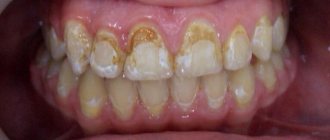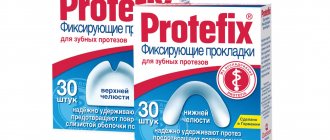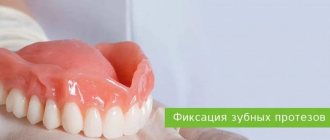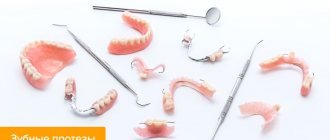What is a nylon prosthesis
Removable nylon dentures are soft orthopedic structures made of a pink, gum-colored nylon base with invisible clasps that hold it in the mouth. The fixation is on the adjacent teeth; the hooks wrap around the supports, keeping the prosthesis stationary on the jaw. Artificial crowns are placed on an elastic frame.
A person can take off and put on a nylon prosthesis without assistance. They are used in dentistry as a temporary solution during implantation (during the process of osseointegration) or as a permanent prosthesis according to indications.
Nylon is a polymer that has the quality of flexibility, and under certain conditions, in the patient’s mouth, softness increases. As a denture material, it has come as an alternative to dental acrylic, to which some people are allergic.
Partial nylon prosthesis RUR 40,000. for all!
The price includes: diagnostics, impressions, manufacturing, installation, fitting and 1 year warranty! Complete denture Akrifri 1 jaw - 47,000 rub.!
Consequences of a loose prosthesis
Dentures are installed in order to restore the dentition, restore the previous functionality for high-quality chewing of food, and restore the beauty of the smile. The best solution is to install fixed dentures and implants. But sometimes you cannot do without removable, conditionally removable dentures. A well-installed structure is reliable and does not require grinding of adjacent teeth, which is one of the biggest advantages. However, a poorly installed prosthesis leads to many serious problems;
- Constant rubbing of the gums, which can even develop into cancer;
- Distortion of speech and even facial expressions;
- Pieces of food getting under the prosthesis, which leads to inflammatory processes;
- Accidental loss of the prosthesis during a conversation or even during sleep;
- Psychological stress leading to decreased self-esteem and the emergence of self-doubt.
If your denture becomes loose in the first days after installation, you should discuss this with your doctor. Perhaps there are anatomical features that make it difficult for the doctor to achieve ideal fixation of the prosthesis. However, in many cases it is possible to improve fixation through adjustment.
Stages of manufacturing a flexible prosthesis
To create nylon dentures, you must first treat the teeth, perform removal according to indications, and then proceed to the following steps:
- taking impressions of jaws in a clinical setting;
- plaster models are made in the laboratory;
- a wax prototype of the prosthesis is cast, tried on, and finalized;
- a nylon final version is created, matched to the color of the gum. The equipment used is a heat press, in which polymer granules are melted and an individual mold is poured in a liquid state. After hardening, the structure is polished.
Clasps are a continuation of nylon dentures and are therefore completely invisible on the jaw even when smiling and talking.
How to manage without dentures?
Alas, you cannot do without prosthetics. The loss of even one tooth disrupts the harmony in the oral cavity. In place of a lost tooth, the skin becomes less elastic, the correct oval of the face is lost over time, and signs of aging appear. The load on the remaining teeth increases. The jaw bone becomes thinner and the gum structure changes.
After tooth extraction, less blood flows into this area of tissue, and the number of blood vessels in the area where the tooth is missing decreases. As a result, the structure of the jaw bone is disrupted. All these processes then lead to displacement of the dentition, to an incorrect bite. And this, in turn, affects the quality of chewing food and disrupts the digestion process.
Even a person’s speech is impaired. Due to the absence of individual teeth, it is impossible to pronounce some sounds correctly. Especially if the problem affects the front teeth. Moreover, the absence of the front row of teeth leads to changes in the nasolabial fold. It lengthens, the corners of the mouth droop, and the person begins to look older than his age.
Indications for installation
Indications for removable nylon dentures can be:
- loss of one or more teeth in a row;
- scattered defect;
- absence of all teeth;
- allergy to metal, acrylic;
- if you do not want to grind the supporting teeth for dentures, for example, clasp ones with locks;
- periodontal disease of 1st and 2nd degrees to keep teeth in place (but 3.4 degrees will already be a contraindication);
- patient refusal or medical contraindications to implantation;
- childhood, if necessary, hide early tooth loss;
- as a temporary solution for implantation with delayed loading.
Sometimes nylon dentures can be installed to treat bruxism, involuntary grinding in the mouth, which damages tooth enamel and increases wear. And also for athletes and people involved in traumatic sports, a flexible design is the best option, better than acrylic, which can easily break in case of injury.
Methods of prosthetics of the anterior upper units
- Veneers. They are thin porcelain plates with a shade completely similar to the color of natural teeth. Veneers are made to fit the contour of the patient’s teeth, so they fit him perfectly. Thin plates are installed on the front of the units and solve the following problems:
- Filling interdental gaps.
- Leveling tooth enamel.
- Concealing dark spots and yellowed tooth enamel.
- Masking cracks and chips.
- Alignment of teeth.
Veneers can be:
- Composite (direct) - the veneer material is applied and formed directly on the tooth.
- Ceramic (indirect) – made from pre-made impressions of the patient’s teeth, formed in the laboratory, and then attached to the teeth. Ceramics has high aesthetic properties and is as similar in appearance and properties as natural tooth enamel.
- Lumineers. These are ultra-thin veneers, the thickness of which is only 0.2 mm. Considering the fact that lumineers are installed without grinding the tooth enamel, they do not always fit tightly and have a risk of coming off. The disadvantage of lumineers is the fact that the teeth covered with them protrude slightly forward compared to units without dentures. Therefore, when prosthetics is applied to one tooth, it will stand out strongly against the background of the rest of the units.
Lumineers and veneers have the following advantages:
- Painless installation.
- Long service life.
- The prosthetic procedure takes little time.
- Lumineers can be installed without grinding the enamel.
- Teeth under veneers and lumineers are protected from the harmful effects of oral microorganisms.
- Crowns. Artificial crowns are installed in cases where teeth are severely damaged. Such dentures allow you to preserve the tooth root. In this case, before prosthetics, the specialist carries out the necessary treatment of the affected tooth. Under the crown, the remaining part of the dental unit will remain intact. The crowns are fixed with special dental cement.
- Dental bridge. This design allows you to simultaneously restore several lost teeth in a row. A bridge is a structure consisting of a false tooth sandwiched between two dental crowns. These crowns are placed over the teeth on either side of the gap and are secured. The benefit of dental bridges is that they prevent surrounding teeth from shifting.
Contraindications
What may be a contraindication to a nylon prosthesis in dentistry:
- periodontal diseases (grade 3-4 periodontal disease), loose teeth, their displacement;
- recession;
- the height of the supporting teeth is not enough, the clasps will not be able to securely fasten;
- inflammatory processes of the mucous membrane and gums;
- tooth mobility;
- significant bone atrophy.
It is necessary to have healthy teeth on both sides of the prosthesis as supports for clasp fixation.
Troubleshooting methods
The list of techniques used to ensure the seating density of the replacement structure includes:
- Adjustment of configuration and replacement of fixing elements;
- Use of adhesives;
- Implantation of mini-implants;
- Complete replacement of the prosthesis.
In some cases, it is possible to avoid adjusting the prosthesis - to do this, it is necessary to teach the patient how to control the masticatory muscles. Proper biting and chewing of food ensures even distribution of the load, which eliminates the possibility of displacement of the replacement structure.
Varieties
There are:
- mini dentures for 1-2 teeth;
- partial (in the absence of three or more teeth);
- complete (replacing the dentition of the entire jaw).
Many people mistakenly believe that all flexible prostheses are nylon. This is wrong. They are very similar to the touch and in some characteristics. However, they should be considered separately.
Quadrotti prosthesis
A special modern type of prosthesis, which stands somewhere between clasp and nylon. It is more durable than the latter, has a little flexibility, and the fasteners are also not visible, unlike the clasp design, where, perhaps, this is the only drawback. The material of manufacture is monomer-free plastic.
Immediate prosthesis “butterfly”.
This is just a type of nylon prosthesis. It is used in cases where one, or less often, two teeth are missing. Small design, good replacement for a lost dental element. Produced quickly. The supporting teeth are not affected, that is, the doctor does not grind them down, they remain healthy and serve their term.
Which removable dentures are better for the lower jaw?
Not all orthopedic solutions are equally effective for installation on both jaws, because each of them has its own distinctive features. The individual characteristics of the lower jaw largely determine the choice of a specific design model, since other dentures can cause discomfort or be poorly fixed in the oral cavity. Let us consider the features of choosing dentures for the restoration of the lower dentition.
Rules of care and wearing features
In order for the prosthesis to look aesthetically pleasing throughout the entire period of use, you should adhere to simple rules for caring for it:
- brush your teeth and teeth 2 times a day;
- the toothbrush should have soft bristles and the toothpaste should be non-abrasive;
- After each meal, also clean the product or rinse your mouth with water if it is not possible to remove and thoroughly wash the denture;
- take it to the dentist for professional cleaning twice a year;
- do not store in a dry place;
- periodically use a special solution to disinfect and clean removable dentures.
Reasons for poor fixation
- Incorrect fit of the prosthesis initially;
- Over time, the size of the gum and jaw have changed;
- Prosthesis care violations.
In rare cases, it happens that even a fixed prosthesis begins to wobble. The reason is that the cement on which the crown was fixed may lose its strength after a few years. In this case, you should immediately contact a specialist who knows how to fix the denture without damaging it. The crown can be carefully removed and reinstalled with new cement. More often, this problem affects those who installed crowns many years ago. Modern cement for fixing the prosthesis is much more durable.
Advantages
An undoubted advantage is the aesthetic appearance, better than that of acrylic and clasp structures. And:
- light weight, which is a significant factor for the upper jaw, where a person feels every gram of a foreign body;
- small basis. There is no wide part blocking the sky, like the plate analogue, which is much more comfortable;
- quick addiction is due to the two points above;
- “invisible prosthesis”, invisible to others, a person can laugh and talk without hesitation. Nylon, in this sense, is a good material; it perfectly imitates gums. And since the clasps are a continuation of the base and are of the same color, they are attached directly to the gums behind the supporting tooth, so they are not visible. What is an advantage over metal visible hooks of clasp structures and acrylic ones;
- hypoallergenic. The production does not use toxic monomers that are added to the plastic mass of acrylic prostheses. They are the ones who cause allergies in patients. By the way, other alternatives to prosthetics have appeared for such sensitive people - Acry Free;
- there is no metallic taste in the mouth due to the absence of metal in the composition;
- The next plus will be felt by people who have a small mouth. Opening it wide to install a large prosthesis is not very comfortable. But not in this case. Nylon bends easily and does not require such sacrifices from patients.
Flaws
It cannot be said that all the disadvantages that we describe below apply to mini-prostheses. They are the ones who receive the least number of complaints. But larger designs definitely have the following negative nuances:
- uneven load when chewing and discomfort when chewing food. The base is flexible and when bitten it bends even more, all the pressure goes to one area, which causes pain. Since the load is not distributed over the entire prosthetic bed, the tissues underneath it atrophy;
- rapid atrophy. Under any removable denture this process occurs and the height of the alveolar ridge is lost. You can find figures about 1mm per year. Loss of tissue leads to subsidence of the prosthesis;
- damage to the gums in the area of clamp fixation. Unlike the clasp type and the plate type, where the hooks wrap around the neck of the supporting tooth, nylon dentures have a gingival attachment. Therefore, the load when chewing is transferred not to the tooth, but to the gum, which over time injures it;
- a fairly rapid decline in aesthetics. Nylon scratches, becomes sticky over time, and attracts dirt;
- beyond repair;
- short service life - up to 5 years and at the same time the need for frequent corrections.
Options for removable orthopedic solutions for the lower jaw
Clasp dentures
Currently, a clasp denture is one of the best solutions for partial restoration of teeth. The design involves the presence of a strong metal arch, to which a light pink base made of nylon or plastic is attached, and artificial crowns are fixed on it. There is no bulky overlap in the sublingual area, but only a thin arc that is practically not felt, and certainly does not affect comfort and taste in any way.
“So, I’ll tell you about my impressions of the clasp prosthesis. Before him, I went with nylon and it was terrible. Unlike its predecessor, the clasp version on the lower jaw is much more convenient. At first there were minor problems with diction, but these were minor things, I just had to get used to it. The denture stays firmly in the mouth, does not interfere with eating and talking, and does not emit an unpleasant odor. Excellent solution, of course, if you are not allergic to metal. By the way, I don’t feel any metallic taste either.”
Alena Shep, Moscow, review from flamp.ru
The main advantages of this type of prosthesis include increased strength and a short adaptation period. The convenient design allows you to evenly distribute the load when chewing, and is characterized by the absence of overlap in the sublingual area, which significantly increases the level of comfort. Among the disadvantages are the relative level of aesthetics due to the presence of metal fasteners, the need to prepare abutment teeth, as well as the high cost when choosing a model with attachments. In addition, this option is not suitable if we are talking about the absence of all teeth.
Clasp denture with locks
The clasp version with clasps will cost from 20 thousand rubles, while the model with micro-locks will cost significantly more - from 50 thousand. This cost usually includes payment for materials and specialist work.
Quadrotti dentures
Quadrotti is based on the soft elastic material Dental D. Thanks to its properties, it copes well with high loads, does not cause allergic reactions, and is also simple and easy to process. Dentures made from Dental D do not contain hard metal parts, which not only interfere with aesthetics, but also cause a lot of inconvenience. The material is fully validated by clinical studies conducted throughout the world over the past ten years 1 .
“In my opinion, Quadrotti is greatly overrated. No, the prosthesis is comfortable, you can’t argue with that, but I definitely haven’t had anything like that, just WOW. Before this I went with a clasp apparatus and now I don’t feel much difference. While I’m still in the period of getting used to it, it’s still a little difficult to speak, and even more so to chew. They promised that there would be no discomfort, but the artificial gum still rubs a little. Otherwise, the option is good, it looks, at least, very natural.”
Irina L., Perm, review from otzovik.com
The advantages of this model include excellent aesthetic characteristics, strength of fixation, and minimal risk of developing allergies. Such dentures are very comfortable and durable. Additionally, they can be flavored with chocolate, vanilla or citrus flavors. Among the disadvantages of Quadrotti are the high cost of the device, as well as the need for regular relocation of the prosthesis.
Quadrotti on the lower jaw
On average, the cost of manufacturing and installing a Quadrotti prosthesis for one lower jaw is 40 thousand rubles. The amount includes the cost of materials and payment for the work of specialists.
Acrylic prosthesis
Acrylic structures for partial tooth replacement are equipped with hard clasps, which often rub and can injure soft tissues and oral mucosa. This solution cannot be called convenient, but it often becomes the best choice when the patient is financially limited. With complete edentia, these dentures are fixed quite well. Moreover, their cost is from 15 thousand rubles.
Expert opinion
Roman Borisovich Alekperov
orthopedic dentist
Experience: 24 years
The choice of flexible prostheses is based mainly on the patient’s desire to receive maximum comfort from wearing an orthopedic structure. Nylon or silicone prostheses do not require long-term adaptation - made from an individual cast, they immediately sit comfortably and allow you to chew food and speak normally. It is important to remember that long-term wearing of flexible prostheses can lead to the development of atrophic processes in bone tissue, since these structures do not have a rigid base. Do not use flexible dentures for more than 6-9 months if you are planning to have implants. If such a situation occurs and the bone is “gone,” it will be necessary to pre-build it or perform basal implantation.
Prosthetics
Examples of work “Before” and “After”
Partial restoration of teeth on both jaws
Case: partial absence of teeth on both jaws.
Complete prosthetics of the upper and lower jaws
Case: absence of teeth in the upper jaw (completely), absence of an orthopedic structure in the lower jaw on existing implants (installed in the USA two years earlier) Work: production of a complete removable denture in the upper jaw as a temporary structure until the installation of one-stage implants with subsequent prosthetics.
Installation of plate dentures with complete edentia (April 2012)
Case: complete absence of teeth in the upper and lower jaws, weak fixation of the removable denture in the lower jaw.
Complete absence of teeth in the upper jaw
Case: Completely edentulous upper jaw Work: Complete removable plate denture - acrylic Number of visits: 4 Time: 2 weeks Cost: 25,000 rub.
Correction of an incorrectly manufactured complete denture base
During the delivery of complete dentures, errors are possible, caused in some cases by incorrect determination of the central relationship of the jaws or violations in the process of laboratory production of dentures, in others - by incorrect determination of the lower third of the face or the boundaries of the prosthetic field.
However, one of the most serious and most common disadvantages of complete dentures is their poor fit. The tissues under such prostheses are often subject to mechanical trauma, which leads to pathological changes. The reasons for poor fixation of complete dentures are: shortened or elongated edges of the denture base; discrepancy between the base of the prosthesis and the relief of the hard palate or alveolar process of the lower jaw; lack of space for the torus palatinus and other bony protrusions; the tissue of the soft palate is not pressed upward with an individual spoon before and during the impression; anatomical formations on the lower jaw (sublingual and retroalveolar spaces, mandibular tubercles) are not used to hold the lower denture; the edges of the prosthesis do not correspond to the edges of the obtained functional impression; poor quality prints; the edges of the prosthesis cover the frenulum and folds; there is not enough space for the free functioning of the language, etc.
Heringer compasses
If the edges of the prosthesis are elongated, then hyperemia appears in places of increased pressure, and then pressure sores occur. In this case, during contraction of the muscles on which the edges of the prosthesis are located, the prosthesis is displaced from its bed.
Correction of the prosthesis should be made when hyperemia appears, since subsequently, when bedsores form, accompanied by pain and inflammatory infiltration of surrounding tissues, the boundaries defining the area of the elongated edge of the prosthesis are erased.
To accurately determine the elongated boundaries of the prosthesis, dentin or gypsum powder is applied to the hyperemic areas and the prosthesis is applied to the jaw. The areas marked on the prosthesis with white powder are the places of correction. If the edges of the prosthesis are shortened, they are lengthened with wax, formed in the patient’s mouth, and the wax is replaced with plastic.
Functional overload of teeth
M.A. Napadov and V.Yu. Kurlyandsky (1955) recommend correcting the base of the prosthesis and its edges directly in the patient’s mouth using quick-hardening plastic. There are other ways to reline dentures. However, using them, we did not always obtain satisfactory results.
The following method of correcting the base of the prosthesis on the lower jaw turned out to be more reliable.
Using fast-hardening plastic, areas of the prosthesis extending into the retroalveolar and sublingual spaces are supplemented, and if the base is narrowed, it is expanded from the vestibular side in the area of the lateral teeth. Excess plastic on the inner surface of the prosthesis base, which restricts the movements of the tongue, is cut off, and a recess is made between the molars and premolars on the vestibular surface of the prosthesis base for applying a retainer. After this, an orthocore plate is applied to the base of the prosthesis, the edges of which end on the vestibular and lingual surfaces. Excess orthocore is cut off in such a way as to form a smooth transition to the base of the prosthesis. Orthocor is heated in hot water, the prosthesis is placed on the lower jaw and secured with a retainer. Then the patient is asked to carry out the full range of chewing, swallowing and other functional movements, as well as to make phonetic correction of the edges of the prosthesis. In areas where the edges of the prosthesis are exposed, the latter are shortened, covered again with orthocor and reinserted into the oral cavity. Having completed the correction, the prosthesis is plastered into a ditch and the orthocor is replaced with plastic in the laboratory. The finished prosthesis is handed over to the patient and the dentition is corrected under the control of carbon paper, achieving smooth gliding of the dentition.
Anatomical articulator design and model fixation technique
If the complete upper denture is poorly fixed, then the cause of poor fixation is determined. If the posterior edge of the prosthesis is located 2-3 mm posterior to the blind foramina and overlaps them, it should be assumed that the soft palate was not pressed upward when taking a functional impression. In this case, a narrow strip of heated wax is placed on the back edge of the prosthesis, and the tissue of the soft palate is pressed out with it. As a result, the prosthesis begins to stick, which confirms the correctness of the assumption made.
In cases where the prosthesis does not cover the blind holes, its posterior edge is lengthened. For this purpose, the wax plate is heated and folded into 2 layers so that the upper one is a continuation of the prosthesis, and the lower one extends to its surface facing the oral cavity. The wax plate is fixed to the prosthesis using a heated spatula. The prosthesis is inserted into the oral cavity and the wax part is pressed upward on the soft palate, cooled in water and reinserted into the oral cavity. If the prosthesis begins to stick, it should be assumed that its posterior edge has been shortened. If, when you press your fingers on the front teeth, the prosthesis is well fixed on the jaw, this means that its rear edge not only properly presses the soft palate upward, but also has a sufficient length.
A.I. Betelman and co-authors (1954) recommend marking the posterior border of the prosthesis on the soft palate with a blue pencil, getting a pencil imprint on the back of the prosthesis and cutting off excess wax outside the valve area. If using wax it was possible to eliminate the cause of poor fixation, the prosthesis is plastered in a ditch, the wax is replaced with plastic and the prosthesis is given to the patient.
If using the described manipulations it was not possible to improve the fixation of the prosthesis, the back side is covered with a heated strip of wax, it is strengthened and, after heating the wax strongly on an alcohol lamp, the prosthesis is inserted into the patient’s mouth. Holding the prosthesis on the jaw, the patient is asked to functionally design its edges. After clarifying the boundaries of the prosthetic field 2-3 times and cooling in water, the prosthesis should stick, as a valve will form under it. However, in some cases this does not happen, and the prosthesis, at the slightest tension of its soft tissues, begins to “slide” from the jaw. Consequently, the excessively elongated sides of the prosthesis are located much above the neutral zone on the moving soft tissues. In these cases, it can be difficult to correct the denture by shortening its sides using wax. Sometimes more serious deficiencies cannot be eliminated at all, and the prostheses must be remade.










